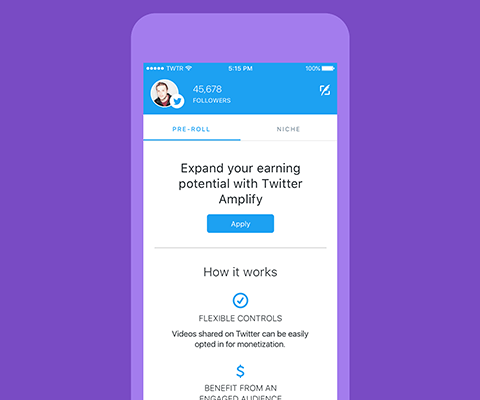-
Tips for becoming a good boxer - November 6, 2020
-
7 expert tips for making your hens night a memorable one - November 6, 2020
-
5 reasons to host your Christmas party on a cruise boat - November 6, 2020
-
What to do when you’re charged with a crime - November 6, 2020
-
Should you get one or multiple dogs? Here’s all you need to know - November 3, 2020
-
A Guide: How to Build Your Very Own Magic Mirror - February 14, 2019
-
Our Top Inspirational Baseball Stars - November 24, 2018
-
Five Tech Tools That Will Help You Turn Your Blog into a Business - November 24, 2018
-
How to Indulge on Vacation without Expanding Your Waist - November 9, 2018
-
5 Strategies for Businesses to Appeal to Today’s Increasingly Mobile-Crazed Customers - November 9, 2018
Twitter to share ad revenue on videos by US individual users
Twitter (TWTR) announced Tuesday morning that it would be going after content creators by allowing them to earn money on the videos they post.
Advertisement
Tuesday, Twitter said it was widening its Amplify ad program to let approved creators in the U.S. make money off their videos.
Unlike YouTube, which gives 55 percent of the money to creators and keeps 45 percent, Twitter is using the same revenue split it already offers other Amplify video partners, like the National Football League: 70 percent to the content creator and 30 percent back to Twitter, according to a person familiar with the arrangement.
Last October, Twitter modified Amplify so all publishers had to do was upload their videos to video.twitter.com to start monetizing their content and get paid the majority of the ad revenue – reports say 70% (versus YouTube’s 55%) – through automated rev-share payments. Creators can choose to monetize Tweet-by-Tweet, or pre-set a monetization option for all of their videos.
Perhaps more excitingly, there’s a non-exclusivity clause, which will allow creators to monetize their content on other sites, most notably YouTube.
Video has an obsession for internet and telecom companies this year, including Twitter’s bigger rival Facebook. VentureBeat’s Ken Yeung has suggested that the cost per advert might be high, due to the limited supply of created content. It’s safe to imagine that the earlier creators to subscribe to this program could win out.
Moreover, Twitter’s plan is a way to strengthen itself against its competitors such as Facebook (FB) and YouTube for elite content creators that often bring in millions of devoted fans. For Twitter, emphasizing live video is a tactic in its fight for mainstream appeal. CEO Jack Dorsey noted in an April shareholder letter that supporting creators and influencers was a top priority for Twitter over the next year. In June, Twitter said that tweets with video have climbed by more than half since the start of the year, at roughly the same time when the number of people who use Twitter once a month grew only about 3 percent. Upgrades include adding a media library for videos, GIFs and images, along with new tweet scheduling and planning features, and team management support.
Twitter has always represented a bit of a raw deal for creators when it comes to monetization.
Twitter is a real-time information network that connects you to the latest information about what you find interesting.
Advertisement
Track Twitter’s Landscape to stay on top of the industry.




























